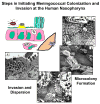Biology and pathogenesis of the evolutionarily successful, obligate human bacterium Neisseria meningitidis
- PMID: 19477055
- PMCID: PMC2712446
- DOI: 10.1016/j.vaccine.2009.04.070
Biology and pathogenesis of the evolutionarily successful, obligate human bacterium Neisseria meningitidis
Abstract
For at least two hundred years, Neisseria meningitidis (the meningococcus), the cause of epidemic meningitis and sepsis, has inflicted rapid death, disability and fear on disparate human populations. The meningococcus is also recognized as a highly successful commensal organism exclusively found in humans. The evolution of N. meningitidis as an exclusive human commensal and sometimes a fulminant and fatal pathogen represents an important case study in microbial pathogenesis. We review the general status of our knowledge of pathogenesis of meningococcal carriage, transmission and virulence behavior with particular emphasis on the relevance of research on this topic to vaccine development.
Figures
References
-
- Vieusseux M. Mémoire su la maladie qui a regné a Genêve au printemps de 1804. J Med Chir Pharmacol. 1805;11:163.
-
- Danielson L, Mann E. Letter to Medical and Agricultural Registrar. Boston, MA: 1806.
-
- Rosenstein NE, Perkins BA, Stephens DS, Popovic T, Hughes JM. Meningococcal disease. N Engl J Med. 2001;344(18):1378–88. - PubMed
-
- Stephens DS, Greenwood B, Brandtzaeg P. Epidemic meningitis, meningococcemia and Neisseria meningitidis. Lancet. 2007;369(9580):2196–210. - PubMed
-
- Marchiafava E, Celli A. Spra i micrococchi della meningite cerebrospinale epidemica. Gazz degli Ospedali. 1884;5:59.
Publication types
MeSH terms
Substances
Grants and funding
LinkOut - more resources
Full Text Sources
Other Literature Sources
Medical


